Archive
- Behind the Screens 9
- Bright Young Things 16
- Colour Palette 64
- Dress Ups 60
- Fashionisms 25
- Fashionistamatics 107
- Foreign Exchange 13
- From the Pages of… 81
- G.U.I.L.T. 10
- Little Trifles 126
- Lost and Found 89
- Odd Socks 130
- Out of the Album 39
- Red Carpet 3
- Silver Screen Style 33
- Sit Like a Lady! 29
- Spin, Flip, Click 34
- Vintage Rescue 20
- Vintage Style 157
- Wardrobe 101 148
- What I Actually Wore 163
The Luxury Hat
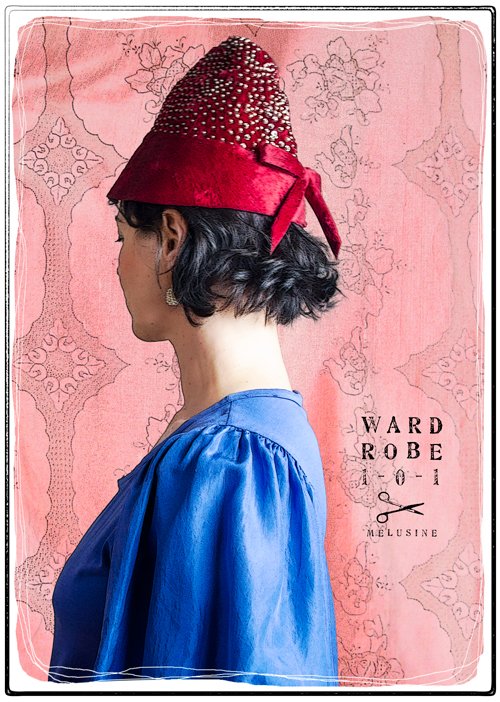 Felt is an ancient fabric, and perhaps the first made by man: it is made rather easily as it is not woven and does not require a loom. According to legend, in the Middle Ages a wandering monk named St Clement – destined to become the fourth bishop of Rome – happened upon the process of felt-making quite by accident. It is said that to make his shoes more comfortable, he stuffed them with tow (short flax or linen fibres). Walking in them on damp ground, he discovered that his own weight and sweaty feet had matted the tow fibres together into a kind of cloth. After being made bishop (with the power to indulge his whimsy), he set up a workshop to develop felting production … and thus he became the patron saint for hatmakers, who of course use felt to this day.
Felt is an ancient fabric, and perhaps the first made by man: it is made rather easily as it is not woven and does not require a loom. According to legend, in the Middle Ages a wandering monk named St Clement – destined to become the fourth bishop of Rome – happened upon the process of felt-making quite by accident. It is said that to make his shoes more comfortable, he stuffed them with tow (short flax or linen fibres). Walking in them on damp ground, he discovered that his own weight and sweaty feet had matted the tow fibres together into a kind of cloth. After being made bishop (with the power to indulge his whimsy), he set up a workshop to develop felting production … and thus he became the patron saint for hatmakers, who of course use felt to this day.
 Parisian costume, 1826
Parisian costume, 1826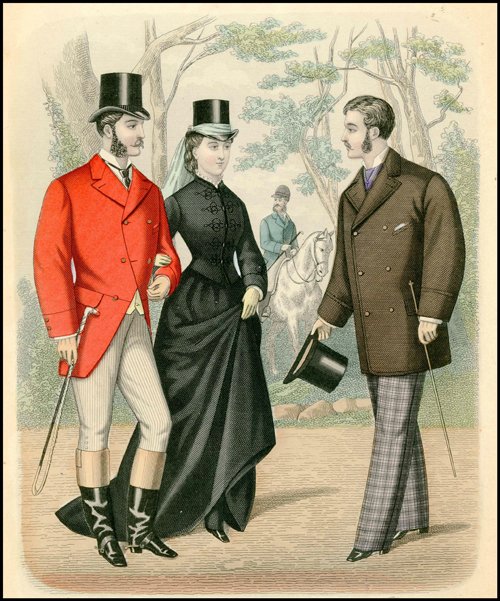 Men and women’s beaver top hats, Gentleman’s Magazine of Fashion, 1876Today most felt is made of wool, but in the past, animal fur was used to make a high-quality felt. Animal fur has tiny, microscopic spines which lock together much like Velcro when heat and moisture are applied. Beaver was the superior fur because its spines were prominent and helped produce a high-quality felt; hats made from it date back to at least the sixteenth century, and they were a staggeringly expensive luxury item. Naturally, to reduce the cost of fur felt, other furs were used such as rabbit or hare, camel, and angora (mohair).
Men and women’s beaver top hats, Gentleman’s Magazine of Fashion, 1876Today most felt is made of wool, but in the past, animal fur was used to make a high-quality felt. Animal fur has tiny, microscopic spines which lock together much like Velcro when heat and moisture are applied. Beaver was the superior fur because its spines were prominent and helped produce a high-quality felt; hats made from it date back to at least the sixteenth century, and they were a staggeringly expensive luxury item. Naturally, to reduce the cost of fur felt, other furs were used such as rabbit or hare, camel, and angora (mohair).
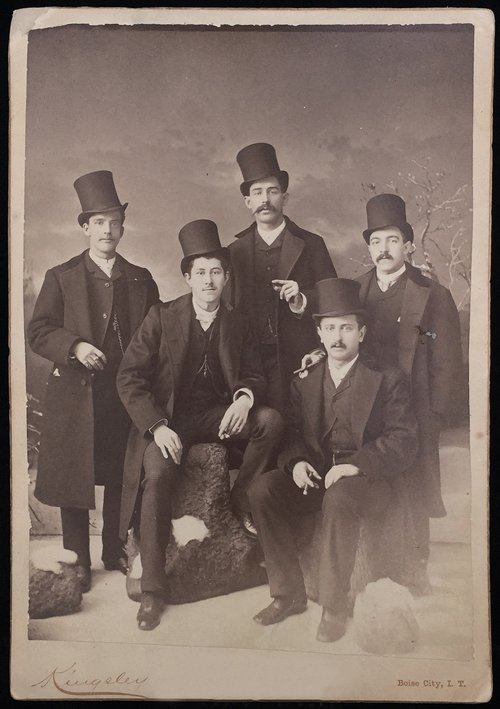 Men wearing beaver hats, 1886But it was another type of hat altogether that toppled the beaver from its luxury perch at last: the silk top hat. First invented in 1797 and scandalising the general public with its fearsome appearance, by the mid nineteenth century, the silk top hat cost half the price of beaver, and overtook it in popularity owing to changes in lifestyle which meant the hardy fur felt hats were not needed.
Men wearing beaver hats, 1886But it was another type of hat altogether that toppled the beaver from its luxury perch at last: the silk top hat. First invented in 1797 and scandalising the general public with its fearsome appearance, by the mid nineteenth century, the silk top hat cost half the price of beaver, and overtook it in popularity owing to changes in lifestyle which meant the hardy fur felt hats were not needed.
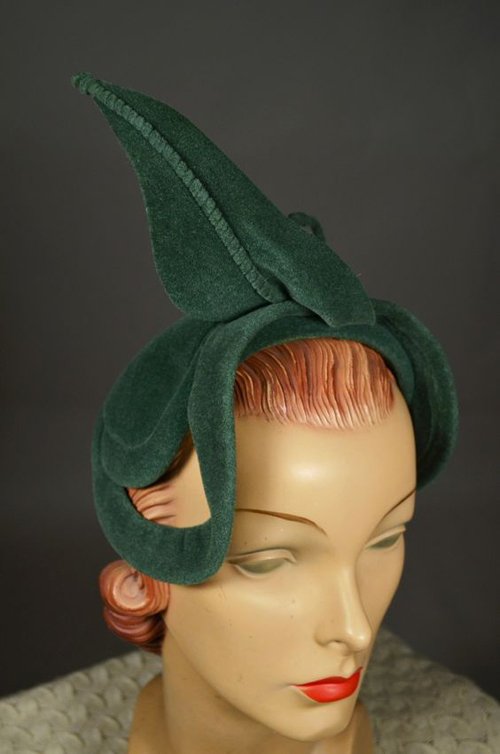 50s hat of angora fur felt; authorised reproduction of a Claude Saint-Cyr designI was initially attracted to this red 1950s pixie hat because of its dramatic shape, and the pearls (which I love) sewn all over it. It is made with Melusine, a felt made from rabbit fur. Melusine has long, fine fibres that are brushed to create a silky long-haired finish. In the past I had presumed ‘fur felt’ was a misnomer, and that such fabric was actually made from wool to look like fur. I was a bit sad when I realised this hat was real rabbit fur; however, at least it is vintage and recycled.
50s hat of angora fur felt; authorised reproduction of a Claude Saint-Cyr designI was initially attracted to this red 1950s pixie hat because of its dramatic shape, and the pearls (which I love) sewn all over it. It is made with Melusine, a felt made from rabbit fur. Melusine has long, fine fibres that are brushed to create a silky long-haired finish. In the past I had presumed ‘fur felt’ was a misnomer, and that such fabric was actually made from wool to look like fur. I was a bit sad when I realised this hat was real rabbit fur; however, at least it is vintage and recycled.
 An amazing pink fur felt reproduction Regency hat, by Jane Walton, 2019I have a few other vintage hats also made from melusine, all from the 50s and 60s. While wool felt is certainly more common these days, you can still buy new fur felt hats (some sources nebulously state the fur is a ‘by-product’) – even top hats made from beaver that are worn by top cats at Ascot – and they are still quite expensive.
An amazing pink fur felt reproduction Regency hat, by Jane Walton, 2019I have a few other vintage hats also made from melusine, all from the 50s and 60s. While wool felt is certainly more common these days, you can still buy new fur felt hats (some sources nebulously state the fur is a ‘by-product’) – even top hats made from beaver that are worn by top cats at Ascot – and they are still quite expensive.
Photo: June 2019
Fashion Plates
 If you have ever wondered why the photography on this fashion journal looks a certain way, or if there was any inspiration behind the artwork, here it is: antique fashion plates!
If you have ever wondered why the photography on this fashion journal looks a certain way, or if there was any inspiration behind the artwork, here it is: antique fashion plates!
The look of SNAP was not a premeditated decision, but evolved out of necessity. Helping out a former colleague with a university project, I wrote and illustrated two stories on sustainable fashion for her. It all happened very, very quickly, and I had to take the photographs in my apartment with no background but a folding screen draped with a calico dropsheet, and I was the model to boot.
 Nor did I have any photographic lighting, so to combat the yellow apartment lighting and dodgy shadows, I developed a style that deliberately emulated the illustrated look of fashion plates with strong outlines and tinted back colours.
Nor did I have any photographic lighting, so to combat the yellow apartment lighting and dodgy shadows, I developed a style that deliberately emulated the illustrated look of fashion plates with strong outlines and tinted back colours.
In magazines, illustrations gave way to photography of course, and the publishing industry suffered a loss. Of course, there has been a slow revival of fashion illustration, and it has become more like art than merely graphic communication, which is all to the good.
 However, there is great beauty in these antique fashion engravings, isn’t there? They look delightfully quaint. I also love how the figures have been taken out of their natural context, and stand against a plain background with no, or very few, props – just like a modern studio photography shoot. They inspire me more than ever.
However, there is great beauty in these antique fashion engravings, isn’t there? They look delightfully quaint. I also love how the figures have been taken out of their natural context, and stand against a plain background with no, or very few, props – just like a modern studio photography shoot. They inspire me more than ever.
Scroll down for more, including a Regency man attired in very high-waisted trousers!





Venus x Abigail
 There is such a joy in op-shopping when one stumbles upon a rare and fabulous find such as this 1970s Regency-inspired maxi dress with shirred bodice in tomato red with slit bell sleeves featuring prints of a hybrid Botticelli Venus-Flora figure. (No fashion journalist could ever have dreamed of penning such a sentence!)
There is such a joy in op-shopping when one stumbles upon a rare and fabulous find such as this 1970s Regency-inspired maxi dress with shirred bodice in tomato red with slit bell sleeves featuring prints of a hybrid Botticelli Venus-Flora figure. (No fashion journalist could ever have dreamed of penning such a sentence!)
I actually must credit a Vinnies staff member for bringing this priceless treasure to my attention, for in my excitement at finding another 70s dress (hand crocheted turquoise) I had unbelievably missed spotting this on the same rack! The lady declared it a quintessential 70s dress, and reminisced how she herself had worn such garments when she was young to her high school prom.
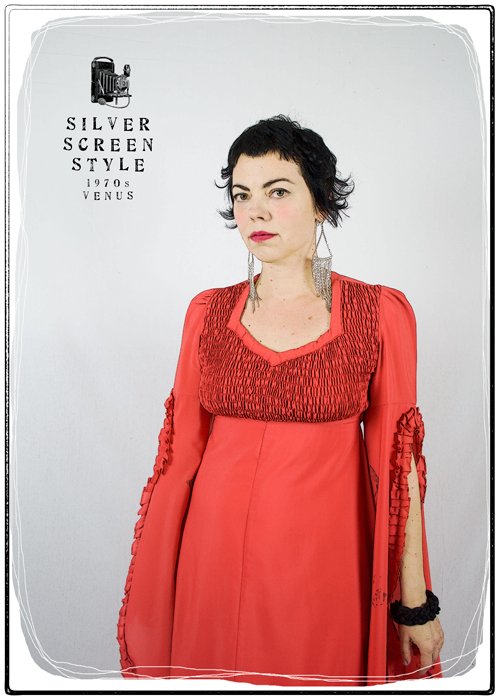 Someone whose chest was too ample to close the zip had actually altered the dress. The back had been opened up and sewn flat, and two sets of ties had been added to the back. I think the fabric for them had been cut off the hem of the dress, as the hem is not very well hand-stitched. When I got it home I unpicked all the stitching, hoping that it would fit me, and fortunately it does.
Someone whose chest was too ample to close the zip had actually altered the dress. The back had been opened up and sewn flat, and two sets of ties had been added to the back. I think the fabric for them had been cut off the hem of the dress, as the hem is not very well hand-stitched. When I got it home I unpicked all the stitching, hoping that it would fit me, and fortunately it does.
Of course the caped sleeves are mind-blowingly awesome, and I also love the little peaked shoulders, but the pièce de résistance is the printed lady. I immediately recognised her as Sandro Botticelli’s Flora, the goddess of flowers and the season of spring depicted in the painting Primavera (painted in the late 1470s or early 1480s) – she’s the one casting flowers about out of the folds of her robe. But what is even funnier, I realised later, is that the head is that of Venus, flipped around, from another of Botticelli’s paintings, The Birth of Venus (1485)! (Was this the designer’s answer to avoiding copyright infringement?)
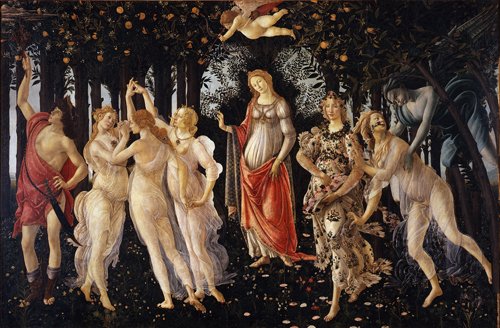 Primavera, Sandro Botticelli (late 1470s or early 1480s)
Primavera, Sandro Botticelli (late 1470s or early 1480s) The Birth of Venus, Sandro Botticelli (1485)The label is Clementine, and states ‘dry clean only’, at which I scoffed as I laid it into a laundry tub of water to hand wash. It is probably a poly crepe, or at best, part rayon as well.
The Birth of Venus, Sandro Botticelli (1485)The label is Clementine, and states ‘dry clean only’, at which I scoffed as I laid it into a laundry tub of water to hand wash. It is probably a poly crepe, or at best, part rayon as well.
The dress really comes to life in movement. I am planning to wear it to the opening night of Abigail’s Party, a 70s period next on stage at the theatre I work at. It is exactly like something the titular character might wear herself. I shall have to make sure to swish and swan about just like her.
 A scene from Abigail's Party (1977), Mike Leigh's film of his own original stage play (Abigail is wearing the red dress)
A scene from Abigail's Party (1977), Mike Leigh's film of his own original stage play (Abigail is wearing the red dress)
Photos: Yesterday (March 2018)
Girls in Pastel
 Here is my family, recently immigrated to Australia, going by the age of my next-oldest sister, Star, the baby in the photo. Innocent pastels were clearly in fashion for young girls at the end of the 60s, for there are my sisters wearing pale pink florals, and blue with white, and white bobby socks with white shoes – quite reminiscent of the Regency period in English fashion. Don’t they look sweet? New country, new clothes.
Here is my family, recently immigrated to Australia, going by the age of my next-oldest sister, Star, the baby in the photo. Innocent pastels were clearly in fashion for young girls at the end of the 60s, for there are my sisters wearing pale pink florals, and blue with white, and white bobby socks with white shoes – quite reminiscent of the Regency period in English fashion. Don’t they look sweet? New country, new clothes.
Texture Tactics

As evidenced by the pages on this Journal, I have very eclectic taste in fashion, and while I would never wear an outfit like the above day-to-day (it’s far too costume-y), what I do like about it is the contrasting textures. As visually appealing as they are though, the real experience is tactile.
Even when colour is minimal, interest can be created with a judicious mix of fabrics and textures. Here herringbone tweed contrasts with various types of lace: butter-soft leather gloves with lace cutwork (amazing!), a Battenberg lace parasol, and crocheted lace inserts in the cotton dress. A blue satin sash adds colour and a sensuous shine against the tweed.
Tactile fabrics are of course always more appealing when they are made from natural fibres. They drape beautifully (think of a genuine silk compared with a cheap polyester fabric), and they also breathe better, keeping you warm in winter and cool in summer. Invest in them and your sense of style will benefit too.


